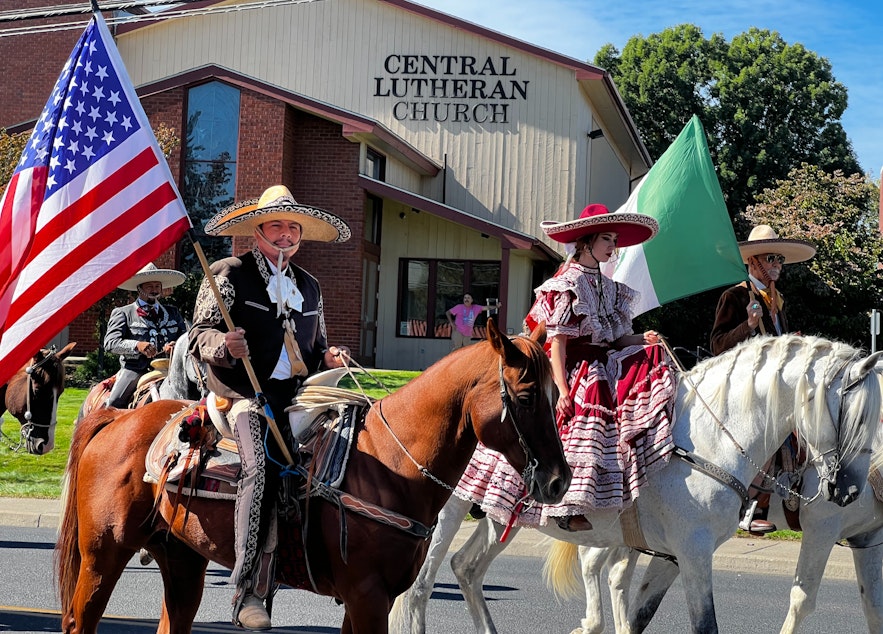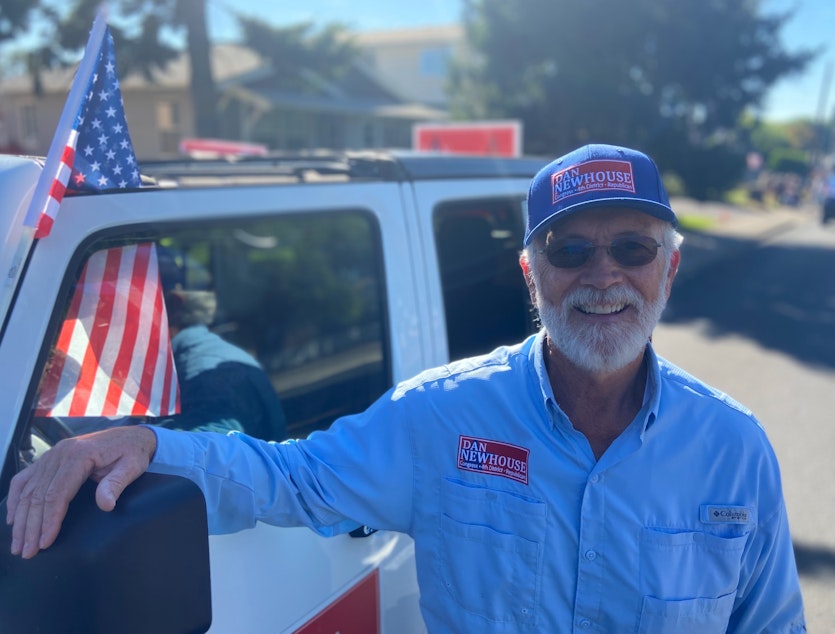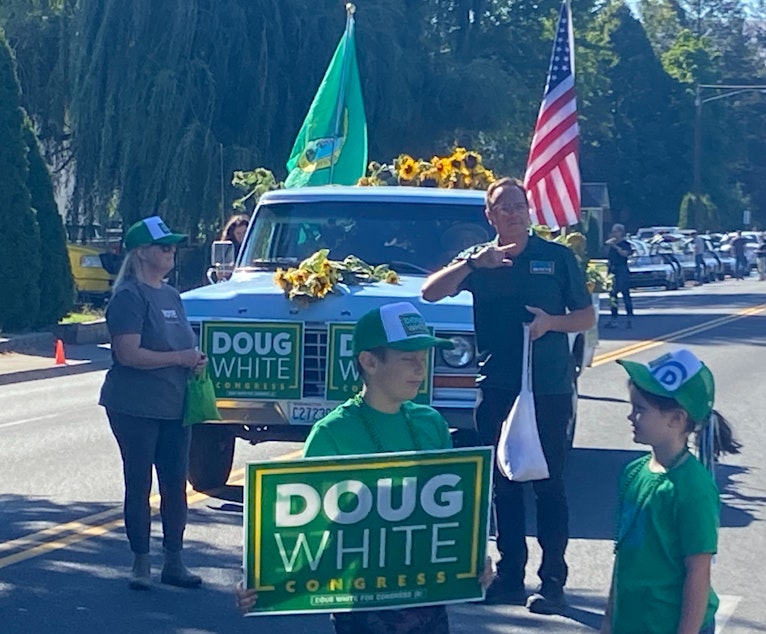Republicans and Democrats vie for Latino voters in the Northwest midterms

Mexican-American “charros,” a group of skilled horse riders in costume, were a highlight of this year’s Sunfair Parade in Yakima.
The usual gaggle of parading politicians was there too, including Republican Congressman Dan Newhouse perched atop a white Jeep Wrangler, waving to potential voters in the 4th Congressional District.
His district has the highest percentage of Latino voters in the state, by far. “Religiously, economically, they fit, I think in my opinion, much better on the Republican side of the political spectrum,” Newhouse said.
After former President Donald Trump made gains with Latinos nationally in 2020, both parties started paying closer attention. And as the 2022 fall elections inch closer, campaigners across the Pacific Northwest are trying to capture a larger share of these voters.
Seattle-based Democratic political strategist Ben Anderstone said that for the first time, he sees evidence that some Latinos in Washington state — who generally vote overwhelmingly Democratic — could be inching right. Anderstone compared the August primary results to his own proprietary election forecast models in the most heavily Latino parts of Washington's 4th Congressional district.
“In the most Latino districts, we saw a shift to the Republicans versus what was expected,” he said. In contrast, Democrats performed about as well as his models expected statewide, but underperformed in “Latino-heavy” areas.
Lea esta historia en español: En el noroeste, republicanos y demócratas se disputan los votantes latinos
Anderstone emphasized that it’s too early to say for sure that Washington is following the 2020 national trend. But for their part, Republicans are projecting optimism.
“This is a big voting bloc that is very much open to considering voting for Republican candidates,” State GOP chair Caleb Heimlich said.
Sponsored
Heimlich said to help make that happen, the GOP has hired a full-time staffer dedicated to Latino outreach in Yakima and the Tri-Cities, and the party opened an office in Wenatchee for the same purpose.
Democrats, including Dan Newhouse’s Democratic Party challenger in the 4th District, Doug White, are fighting back.
“My campaign, for the first time in the history of this district, has hired people to do outreach to these communities to make sure that they are heard, and know they have a place at the table,” White said.


Sponsored
In Oregon, Democrat Andrea Salinas is running against Republican businessman Mike Erickson in the battle over the newly created 6th Congressional District, where around 1 in 5 voters are Latino.
"As the daughter of a Mexican immigrant, I’m incredibly proud of my Latino culture and heritage. The values I learned from my family and from my community have been my guide, not only in this race but throughout my time in public service,” Salinas wrote in a statement to KUOW.

If she wins, Salinas would be the first Latina elected to Congress from Oregon. Some Democrats, including leaders with a key Latino Democratic PAC and the Democratic Congressional Campaign Committee, also hope Salinas will help increase Latino voter turnout this year.
“The DCCC is committed to reaching Latino communities across the country, including here in Oregon’s Sixth District, which is why we’ve launched a historic investment to court, build, and expand Democrats' relationship and commitment to the Latino electorate,” said Teddy Lake with the DCCC in Oregon.
Sponsored
Geraldo Cadava, a professor of history and Latina and Latino studies at Northwestern University who studies Hispanic and Latino Republicans, argues that it’s important to see that there’s no such thing as the “Latino Vote,” only Latino voters.
“Sixty million Americans is not a bloc. Sixty million Americans have never pushed in the exact same direction,” Cadava said.
Post-2020 claims that Latinos are suddenly lurching right, which are being advanced by some political analysts, are missing some important historical context, Cadava said.
“Over the past 50 years, between a quarter and a third of Latinos have voted for Republicans, Cadava said. “Sometimes it's been a little less, sometimes it's been a little more.”
Cadava thinks Latinos may now be voting more Republican than in previous election cycles, particularly people with less formal education who live in rural areas like the Yakima Valley in Central Washington.
Sponsored
“Like a lot of these rural voters, their values are more conservative.” he said. “They have more conservative values than Latinos in cities, and in that sense these Republican Latino voters are a lot like Trump voters elsewhere,” he said.
One common assumption is that some Latino voters may be trending Republican because they’re more socially conservative on issues like abortion. But as Cadava suggests, the reality of Latino voters is more complicated than easy generalizations would indicate.
A recent New York Times poll, for example, found most Latino voters think abortion should be legal in all or most cases. Among younger Latino men, though, economic worries ranked number one in that same poll, and that could be a driving factor in any drift to the right this year.

At the Central Washington Fair in Yakima, Jaime Ibarra said he recently became a U.S. citizen, and plans to vote for the first time this fall at age 31.
Sponsored
“Voting is really important because everything you do now is going to affect the future,” he said.
Ibarra said he leans Democratic, but his political views are more in the middle.
“In some ways, I'm more Democrat than Republican,” Ibarra said. “But in some ways, more conservative on inflation, spending and all that. But I do believe that we should focus a lot on legalizing immigrants and stuff.”

Lupe Lee, who is age 54 and a Latina, was out enjoying the Central Washington fair with her husband Eric Lee. She too leans Democratic but plans to vote Republican in the upcoming Congressional race for the 4th this year.
"I think I'll go Newhouse, just because I'm a little more familiar with him, and I like the part about impeaching Trump," she said.
That impeachment vote is the big twist in the race. Last year, Dan Newhouse provoked a MAGA backlash over his decision to be one of just 10 Republicans in the U.S. House to vote to impeach former President Trump. He told KUOW he doesn't regret the vote, even though some Republicans are still vowing not to support him in the general election.
"There's still a lot of people that are upset about it and angry about it, but I think it was the right thing to do, and I would do it again," Newhouse said.
It's still unclear how much support Newhouse will get this year from Latino voters. But most are still Democrats. Currently in Washington, only around 11% of Latino voters are estimated to be Republicans, compared to 86% Democrats. In Oregon, 10% of Latino voters are thought to be Republican, compared to 33% Democrats and 52% “non-partisan," according to Seattle-based L2 Data mapping.
Deanna Martinez wants that to change. She’s Mexican American, and the new head of a statewide group of self-described moderates called the Mainstream Republicans of Washington. Martinez thinks Republicans have a good opportunity right now with Latino voters in the Northwest.
"They're not going to want to have to pay a whole lot of fees and have a whole lot of government involvement in what they want to do,” she said.
But Democrats believe they still have the advantage with Latino voters.
UCLA professor Matt Martinez is a former Washington resident, and now a pollster for the Democratic Congressional Campaign Committee. He pointed out that nationally, Latinos still vote for Democrats 2-1 over Republicans, and he argues most are closer to Democrats on issues such as health care.
Matt Martinez also noted that Latino voters are the country’s youngest demographic, which means their political views are more fluid. In other words, younger Latino voters represent the future.
“What political parties need to do is connect the dots for these younger voters so by the time they become 50-year-old voters, they're really used to voting Democratic or Republican,” Matt Martinez said.
“Right now, the Democrats have the bigger opportunity to connect the dots for Latinos,” he added.
There’s another opportunity for both parties to grow, Matt Martinez said. Latino turnout is currently extremely low. In Washington's 4th District August primary, the Latino vote was around 35 percentage points lower than white voter turnout, according to consultant Ben Anderstone.
The party that manages to change Latino voter turnout in its favor will be well-positioned for the future.
This story is part of a collaboration among public radio stations in the Northwest News Network covering the 2022 election season.
Want to know more about the voting records and issue positions of candidates? Use the VoteSmart tool below to find out more.




